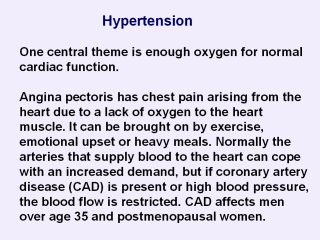| front |1 |2 |3 |4 |5 |6 |7 |8 |9 |10 |11 |12 |13 |14 |15 |16 |17 |18 |19 |20 |21 |22 |23 |24 |25 |review |
 |
Frequent signs are 1/ Tightness, squeezing,
pressure or an ache in the chest, 2/ Sometimes a sudden breathing
difficulty, 3/ Chest pain similar to indigestion (heart burn), 4/ A choking
feeling, 5/ Chest pain that radiates to the jaw, teeth or earlobes, 6/
Heaviness, numbness, tingling or ache in the chest, arm, shoulder, elbow or
hand usually on the left side and 7/ Pain between the shoulder blades. CAD can have 1/ partial blockage or spasm of the arteries that supply blood to the heart, 2/ An overactive thyroid gland, 3/ A heart rate that is too fast.4/ Heart-valve disease and sometimes anemia is involved. Risk of heart attack increases with: 1/ Smoking, 2/ obesity, 3/ diabetes mellitus, 4/ High blood pressure, 5/ High blood cholesterol levels, 6/ Ex-cess intake of fat or salt, 7/ Sedentary lifestyle, fatigue, overwork or stress, 8/ Family history of CAD and 9/ Exposure to cold and wind. The famous treatment is by nitroglycerin that acts instantly against pain. Many other drugs are used including the statins that lower cholesterol levels. |